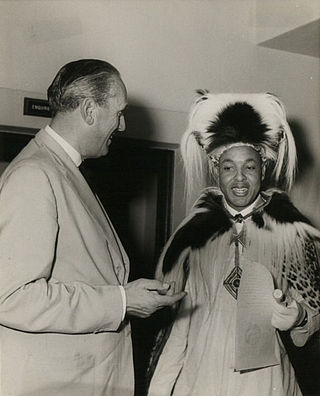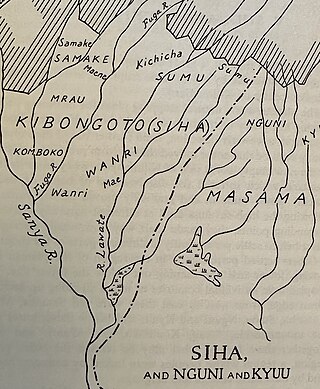
Mount Kilimanjaro is a dormant volcano located in Kilimanjaro Region of Tanzania. It has three volcanic cones: Kibo, Mawenzi, and Shira. It is the highest mountain in Africa and the highest single free-standing mountain above sea level in the world: 5,895 m (19,341 ft) above sea level and about 4,900 m (16,100 ft) above its plateau base. It is the highest volcano in Africa and the Eastern Hemisphere.
The Honourable Sir Charles Cecil Farquharson Dundas, KCMG, OBE was a British colonial administrator who served as Governor of the Bahamas from 1934 to 1937 and Governor of Uganda from 1940 to 1944. He was the fifth son of Charles Saunders Dundas, 6th Viscount Melville.

Marangu is a town located in Moshi District of Kilimanjaro Region. it is divided into Marangu East and Marangu west each with its own village, its one of the famous places in Tanzania recognized as one of the main gate for climbing Mount Kilimanjaro. it is also famous for being a place where Mangi mkuu of chagga Thomas Lenana Marreale was born in Lyamrakana Village on June 15, 1915 who ruled in 1952 up to 1961 when chieftains was abolished..

Chief Thomas Lenana Marealle II OBE (June 15, 1915 – February 14, 2007) was the Paramount Chief (Mangi Mkuu) of the Chagga people of Tanzania and a politician.

The Chagga are a Bantu ethnic group from Kilimanjaro Region of Tanzania. They are the third-largest ethnic group in Tanzania. They historically lived in sovereign Chagga states on the slopes of Mount Kilimanjaro in both Kilimanjaro Region and eastern Arusha Region.
Ongamo, or Ngas, is a probably extinct Eastern Nilotic language of Tanzania. It is closely related to the Maa languages, but more distantly than they are to each other. Ongamo has 60% of lexical similarity with Maasai, Samburu, and Camus. Speakers have shifted to Chagga, a dominant regional Bantu language.

Kilimanjaro Region is one of Tanzania's 31 administrative regions. The regional capital and largest city is the municipality of Moshi. With the 3rd highest HDI of 0.640 in the country, Kilimanjaro is one among the top five most developed regions of Tanzania. According to the 2012 national census, the region had a population of 1,640,087, which was lower than the pre-census projection of 1,702,207. For 2002–2012, the region's 1.8 percent average annual population growth rate was the 24th highest in the country. It was also the eighth most densely populated region with 124 people per square kilometer. The most well-known tribes in the Kilimanjaro region are the chagga, rombos, and pare.

Arusha Region is one of Tanzania's 31 administrative regions and is located in the north of the country. The region's capital and largest city is the city of Arusha. The region is bordered by Kajiado County and Narok County in Kenya to the north, the Kilimanjaro Region to the east, the Manyara and Singida Regions to the south, and the Mara and Simiyu regions to the west. Arusha Region is home to Ngorongoro Conservation Area, a UNESCO World Heritage Site. The region is comparable in size to the combined land and water areas of the state of Maryland in the United States.

Meli or Mangi Meli Kiusa bin Rindi Makindara, also known as, , was a king of the Chaga in Moshi, one of the sovereign Chagga states in the late 1890s. Mangi means king in Kichagga. He was hanged by the German colonial government together with 19 other Chagga, Meru, and Arusha leaders. Thomas Kitimbo Kirenga, Sindato Kiutesha Kiwelu, King Ngalami of Siha, Tanzania, King Lolbulu of Meru, King Rawaito of Arusha, King Marai of Arusha, and King Molelia of Kibosho were among the noblemen on 2 March 1900.

Rombo is one of the seven districts of the Kilimanjaro Region of Tanzania. The district covers an area of 1,471 km2 (568 sq mi). It is bordered to the north and east by Kenya, to the west by the Siha District and Hai District, and to the south by the Moshi Rural District. The Rombo District contains a large portion of Kilimanjaro National Park. According to the 2012 census, the population of the Rombo District was 260,963.

The Taita people are an ethnic group in Kenya's Taita-Taveta County. They speak Kidawida or Kitaita, which belongs to the Bantu language family. The West-Bantu migrated to the Taita-Taveta County around 1000-1300.

Machame or Kingdom of Machame, was a historic sovereign Chagga state located in modern day Machame Kaskazini ward in Hai District of Kilimanjaro Region in Tanzania. Historically, the Machame kingdom was in 1889 referred by Hans Meyer as a great African giant, the kingdom was also the largest and most populous of all the Chagga sovereign states on Kilimanjaro, whose ruler as early as 1849 was reckoned as a giant African king with influence extending throughout all Chagga states except Rombo.
Sia Lives on Kilimanjaro is a children's book written by Astrid Lindgren and with photographs by Anna Riwkin-Brick. The original Swedish edition was published in 1958 by the Rabén & Sjögren publishing company in Stockholm. The English translation was published in 1959, in London by Methuen, and in New York by Macmillan. The book was published as part of the Children's Everywhere photo book series. It is a story of a young girl who wants to visit the king at the Chagga Feast, but her father tells her she is too young, and her brother tells her only boys are allowed. Story about self-determination.

Nathaniel Mtui was a Tanzanian historian of Chagga origin born in 1892 in the mtaa of Mshiri in Marangu, Kilimanjaro Region, Tanzania. He was a teacher at the Colonial German Lutheran mission in Marangu. He is known for being the first person of Chagga origin to write history of the Chagga people. He wrote the Chaggan history in Kichagga, German, and Swahili from 1913-1916.
William Nicholaus Lyimo, popularly known by his stage name Bill Nass, is a Tanzanian rapper of Chagga heritage, he was born in Tanga, Tanga Region. MTV Base named him among the "50 Artists To Watch For In 2017". He is currently based in Dar es Salaam. Months after the release of his debut single "Raha", Lyimo was nominated on 2015's Kilimanjaro Tanzania Music Awards (KTMA) as a "New Best Artist".

Ngalami or Ngalami Mmari, also known as, , was one of many kings of the Chagga. He was the king of one of the Chagga states, namely; the Siha Kingdom in what is now modern Siha District of Tanzania's Kilimanjaro Region from the 1880s to 1900. Mangi means king in Kichagga. Ngalami ruled from the Siha seat of Komboko (Kibong'oto) in the 1880s to 1900 when he was executed in Moshi by the Germans alongside 19 other Chagga, Meru and Arusha leaders. The execution of 19 noblemen and leaders in March 1900, included noblemen Thomas Kitimbo Kirenga, Sindato Kiutesha Kiwelu, King Meli of Moshi, King Lolbulu of Meru, King Rawaito of Arusha, King Marai of Arusha, and King Molelia of Kibosho.
Bwana Kheri was a Swahili long-distance caravan trader who lived in present day Mombasa. He is known for guiding into the interior of the present day northern Tanzania after he guided the German missionary Johannes Rebmann of the Anglican Church Missionary Society (CMS) in late 1848.

The Chagga States or Chagga Kingdoms also historically referred to as the Chaggaland were a pre-colonial series of a Bantu sovereign states of the Chagga people on Mount Kilimanjaro in modern-day northern Kilimanjaro Region of Tanzania. The Chagga kingdoms existed as far back as the 17th century according to oral tradition, a lot of recorded history of the Chagga states, was written with the arrival, and colonial occupation of Europeans in the mid to late 19th century. On the mountain, many minor dialects of one language are divided into three main groupings that are defined geographically from west to east: West Kilimanjaro, East Kilimanjaro, and Rombo. One word they all have in common is Mangi, meaning king in Kichagga. The British called them chiefs as they were deemed subjects to the British crown, thereby rendered unequal. After the conquest, substantial social disruption, domination, and reorganization by the German and British colonial administrations, the Chagga states were officially abolished in 1963 by the Nyerere administration during its third year as the newly independent nation of Tanganyika.

Siha or Kingdom of Siha also sometimes referred to as Kibongoto, was a historic sovereign Chagga state located in modern-day Machame Kaskazini ward in Hai District of Kilimanjaro Region in Tanzania. Siha was located west of the Ushira plateau on Mount Kilimanjaro. The word Mangi means king in Kichagga. The kingdom is known for Mangi Ngalami that was hanged together with 18 other Leaders of the Chagga states including Mangi Meli, by the German colonial regime in 1900.
Rengua or Mangi Rengua Kiwaria Kombe , also known as, , was a king of the Chaga in Machame, one of the sovereign Chagga states in the early 1800s. Mangi means king in Kichagga. Rengua was part of the Kombe dynasty, an imperial dynasty that ruled from Rengua's period in the second half of the 19th century to the 1960s was founded by him. The mangi rule remained with one house (Kombe) throughout all vicissitudes, even intermediate times of anarchy when competing clans were essentially independent and times of deadly family rivalry. He is also infamously remembered for massacring Kibosho initiates at Kinduchi, Lyamuro, bringing on the infamous Kibosho and Machame rivalry. He consolidated Machame as one of the most powerful kingdoms in Chaggaland. Because of this Rengua is considered one of the greatest leaders in Machame history.














